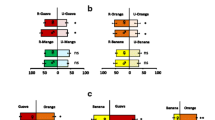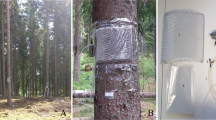Abstract
A previous study on the feeding responses of tsetse flies, Glossina morsitans morsitans, implicated the existence of allomonal barriers, both volatile and nonvolatile, on the nonpreferred host, waterbuck, Kobus defassa. In the present study, electroantennogram-active compounds in odors from waterbuck were compared with those of two preferred hosts of tsetse flies, buffalo, Syncerus caffer, and ox, Bos indicus. Odors from the three bovids were trapped on activated charcoal and/or reverse-phase (octadecyl bonded) silica and analyzed with a gas chromatography-linked electroantennographic detector (GC-EAD) and, where possible, identified by using gas chromatography-linked mass spectrometry (GC-MS) and chromatographic comparisons with authentic samples. The GC-EAD profiles (with G. m. morsitans antennae) of the odors of the two preferred hosts were comparable, comprising medium-chain, saturated or unsaturated aldehydes and phenols, with buffalo emitting a few more EAG-active aldehydes. Waterbuck odor gave a richer profile, consisting of fewer aldehydes but more phenolic components and a series of 2-ketones (C8–C13) and δ-octalactone. This bovid also emits moderate amounts of C5–C9 straight-chain fatty acids, some of which were detected in buffalo and ox only in trace amounts. However, these did not elicit significant GC-EAD responses. Waterbuck profiles from the antennae of G. pallidipes showed broad similarity to those from G. m. morsitans, although the composition of aldehydes and ketones was somewhat different, indicating species-specific difference in the detection of host odors. Certain waterbuck-specific EAG-active components, particularly the 2-ketones and lactone, constitute a candidate allomonal blend in waterbuck odor.
Similar content being viewed by others
REFERENCES
Brightwell, R., Dransfield, R. D., and Kyorku, C. A.1991.Development of a low-cost tsetse trap and odour baits for Glossina pallidipes and G. longipennis in Kenya.Med. Vet. Entomol. 5:153–164.
Bursell, E., Gough, A. J. E., Beevors, P. S., Cork, A., Hall, D. R., and Vale, G. A. 1988.Identification of components of cattle urine attractive to tsetse flies, Glossina spp. (Diptera: Glossinidae). Bull. Entomol. Res.78:281–291.
Clausen, P. H., Adeyemi, I., Bauer, B., Breloeer, M., Salchow, F., and Staak, C. 1998.Host preferences of tsetse flies (Diptera: Glossinidae) based on bloodmeal identifications.Med. Vet. Entomol.12:169–180.
Estes, R.D.1991.The Behavior Guide to African Mammals: Including Hoofed Mammals, Carnivores, Primates.The University of California Press, Berkeley, 520 pp.
Fieser, L. F. and Fieser, M. 1967.Reagents for Organic Synthesis.John Wiley & Sons, New York, pp.972–973.
Furniss, B. S., Hannaford, A. J., Smith, P. W. G., and Tatchell, A. R.1991. Vogel's Textbook of Practical Organic Chemistry,5th ed. Longman, New York, pp.725–735.
Gee, J. D. 1976.Active transport of sodium by malphigian tubules of the tsetse fly Glossina morsitans. J. Exp. Biol. 64:357–368.
Gibson, G. and Torr, S. J. 1999.Visual and olfactory responses of haematophagus Diptera to host stimuli.Med. Vet. Entomol. 13:2–23.
Gikonyo, N. K., Hassanali, A., Njagi, P. G. N., and Saini, R. K. 2000.Behaviour of Glossina morsitans morsitans Westwood (Diptera: Glossinidae) on waterbuck Kobus defassa Ruppel and feeding membranes smeared with waterbuck sebum indicates the presence of allomones.Acta Trop.77:295–303.
Grootenhuis, J. G. 1986.Trypanotolerance in wildlife.Kenya Vet.10:45–46.
Grootenhuis, J. G. and Olubayo, R. O. 1993.Disease research in the wildlife-livestock interface in Kenya.Vet. Q.15:55–59.
Hall, D. R., Beevor, P. S., Cork, A., Nesbitt, B. F., and Vale, G. A.1984.1-Octen-3-ol. A potent olfactory stimulant and attractant for tsetse isolated from cattle odours.Insect Sci. Appl.5:335–339.
Haltenorth, T. and Diller, H. 1996.Collins Field Guide: Mammals of Africa Including Madagascar. Harper Collins, Hong Kong, 400 pp.
Hassanali, A., McDowell, P. G., Owaga, M. L. A., and Saini, R. K.1986.Identification of tsetse attractants from excretory products of a wild host animal, Syncerus caffer.Insect Sci. Appl. 7:5–9.
Lin, S. Y. H., Trumble, J. T., and Kumamoto, J.1987.Activity of volatile compounds in glandular trichomes of Lycopersicon species against two insect herbivores.J. Chem. Ecol.13:837–850.
Lwande, W., Hassanali, A., Mcdowell, P. G., Moreka, L., Nokoe, S. K., and Waterman, P. G. 1992.Constituents of Commiphora rostrata and some of their anologues as maize weevil, Sitophilus zeamais repellents.Insect Sci. Appl. 13:679–683.
Madubunyi, L. C., Hassanali, A., Ouma, W., Nyarango, D., and Kabii, J.1996. Chemoecological role of mammalian urine in host location by tsetse, Glossina spp. (Diptera: Glossinidae).J. Chem. Ecol.22:1187–1199.
McDowell, P. G., Lwande, W., Deans, S. G., and Waterman, P. G.1988.Volatile resin exudate from stem bark of Commiphora rostrata: Potential role in plant defence.Phytochemistry 27:2519–2521.
Mihok, S., Olubayo, R. O., and Wesonga, D. F. 1991.Infection rates in Glossina morsitans morsitans fed on waterbuck and boran cattle infected with Trypanosoma congolense.Acta Trop. 49:185–191.
Moloo, S. K.1993.The distribution of Glossina species in Africa and their natural hosts.Insect Sci. Appl.14:511–527.
Owaga, M. L. A., Hassanali, A., and McDowell, P. G.1988.The role of 4-cresol and 3-npropylphenol in the attraction of tsetse flies to buffalo urine.Insect Sci. Appl.9:95–100.
Packer, M. J. and Warnes, M. L.1991.Responses of tsetse flies to ox sebum: A video study in the field.Med. Vet. Entomol.5:23–27.
Reinouts Van Haga, H. A. and Mitchell, B. K. 1975.Temperature receptors on tarsi of the tsetse fly Glossina morsitans west.Nature 255:225–226.
Saini, R. K., Hassanali, A., Ahuya, P., Andoke, J., and Nyandat, E.1993.Close range responses of tsetse flies Glossina morsitans morsitans Westwood (Diptera: Glossinidae) to host body kairomones.Discovery Inovation5:149–153.
Snow, W. F., Tarimo, S. A., Staak, C., and Butler, L.1988.The feeding habits of the tsetse, Glossina pallidipes Austen on the south Kenya coast, in the context of its host range and trypanosome infection rates in other parts of East Africa.Acta Trop. 45:339–349.
Torr, S. J., Mangwiro, T. N. C., and Hall, D. R.1996.Responses of Glossina pallidipes (Diptera: Glossinidae) to synthetic repellents in the field.Bull. Entomol. Res.86:609–616.
Turner, D. A.1987.The population ecology of Glossina pallidipes Austen (Diptera: Glossinidae) in the Lambwe Valley, Kenya. I. Feeding behaviour and activity patterns.Bull. Entomol. Res. 77:317–333.
Vale, G. A. 1974a.The responses of tsetse flies (Diptera: Glossinidae) to mobile and stationary baits. Bull. Entomol. Res.64:545–588.
Vale, G. A.1974b.Direct observations on the responses of tsetse flies (Diptera: Glossinidae) to hosts. Bull. Entomol. Res.64:589–594.
Vale, G. A. 1977.Feeding responses of tsetse flies (Diptera: Glossinidae) to stationary hosts.Bull. Entomol. Res. 67:635–649.
Vale, G. A.1980.Field studies of the responses of tsetse flies (Glossinidae) and other Diptera to carbon dioxide, acetone and other chemicals.Bull. Entomol. Res. 70:563–570.
Vale, G.A. and Hall, D.R.1985.The role of 1-octen-3-ol, acetone and carbon dioxide in the attraction of tsetse flies, Glossina spp. (Diptera: Glossinidae), to ox odour.Bull. Entomol. Res.75:209–217.
Vale, G. A., Hall, D. R., and Gough, A. J. E.1988.The olfactory responses of tsetse flies, Glossina spp. (Diptera: Glossinidae), to phenols and urine in the field.Bull. Entomol. Res. 78:293–300.
Van Der Goes Van Naters, W. M., Den Otter, C. J., and Cuisance, D.1998. The interaction of taste and heat on the biting response of the tsetse fly Glossina fuscipes fuscipes.Physiol. Entomol. 23:285–288.
Warnes, M. L.1990.Responses of Glossina morsitans morsitansWestwood and G. pallidipes Austen (Diptera: Glossinidae) to the skin secretions of oxen.Bull. Entomol. Res. 80:91–97.
Weitz, B.1963.The feeding habits of Glossina.Bull. WHO 29:711–729.
Willemse, L. P. M.1991.A trial of odour baited targets to control the tsetse fly, Glossina morsitans centralis (Diptera: Glossinidae) in west Zambia.Bull. Entomol. Res. 81:351–357.
Author information
Authors and Affiliations
Corresponding author
Rights and permissions
About this article
Cite this article
Gikonyo, N.K., Hassanali, A., Njagi, P.G.N. et al. Odor Composition of Preferred (Buffalo and Ox) and Nonpreferred (Waterbuck) Hosts of Some Savanna Tsetse Flies. J Chem Ecol 28, 969–981 (2002). https://doi.org/10.1023/A:1015205716921
Issue Date:
DOI: https://doi.org/10.1023/A:1015205716921




